Kuntal Deka
Comprehensive Review of Deep Unfolding Techniques for Next-Generation Wireless Communication Systems
Feb 09, 2025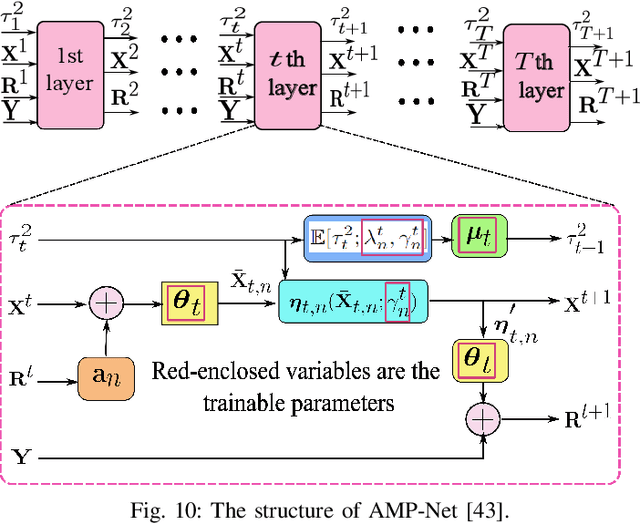
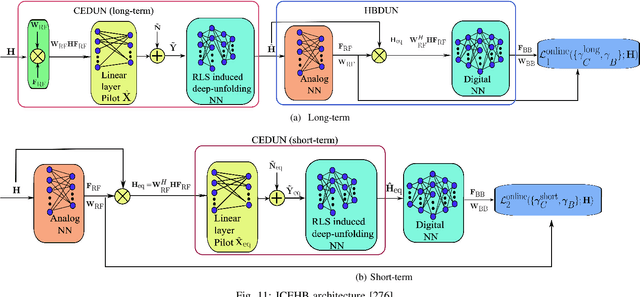
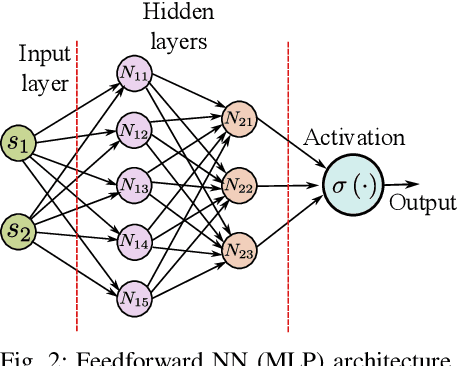
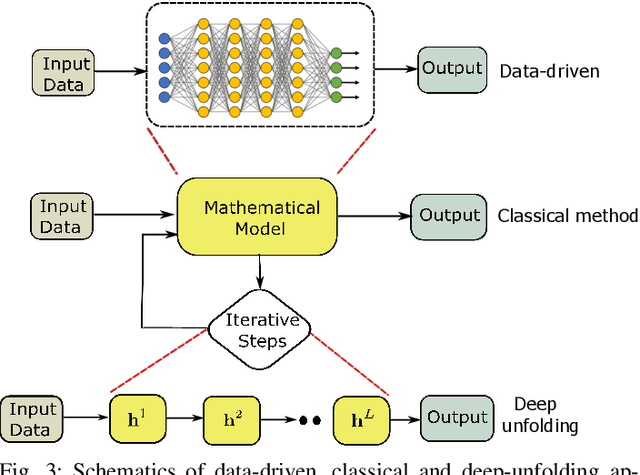
Abstract:The application of machine learning in wireless communications has been extensively explored, with deep unfolding emerging as a powerful model-based technique. Deep unfolding enhances interpretability by transforming complex iterative algorithms into structured layers of deep neural networks (DNNs). This approach seamlessly integrates domain knowledge with deep learning (DL), leveraging the strengths of both methods to simplify complex signal processing tasks in communication systems. To provide a solid foundation, we first present a brief overview of DL and deep unfolding. We then explore the applications of deep unfolding in key areas, including signal detection, channel estimation, beamforming design, decoding for error-correcting codes, sensing and communication, power allocation, and security. Each section focuses on a specific task, highlighting its significance in emerging 6G technologies and reviewing recent advancements in deep unfolding-based solutions. Finally, we discuss the challenges associated with developing deep unfolding techniques and propose potential improvements to enhance their applicability across diverse wireless communication scenarios.
Rate-Splitting Sparse Code Multiple Access
Jan 26, 2025Abstract:This paper presents a novel rate-splitting sparse code multiple access (RS-SCMA) framework, where common messages are transmitted using quadrature phase-shift keying (QPSK) modulation, while private messages are sent using SCMA encoding. A key feature of RS-SCMA is its ability to achieve a tunable overloading factor by adjusting the splitting factor. This flexibility enables an optimal trade-off, ensuring the system maintains superior performance across varying levels of overloading factor. We present a detailed transceiver design and analyze the influence of rate-splitting on the overloading factor. Extensive simulation results, both with and without low-density parity-check (LDPC) codes, highlight RS-SCMA's potential as a strong candidate for next-generation multiple access technologies.
Prior Information-Aided ADMM for Multi-User Detection in Codebook-Based Grant-Free NOMA: Dynamic Scenarios
Oct 22, 2024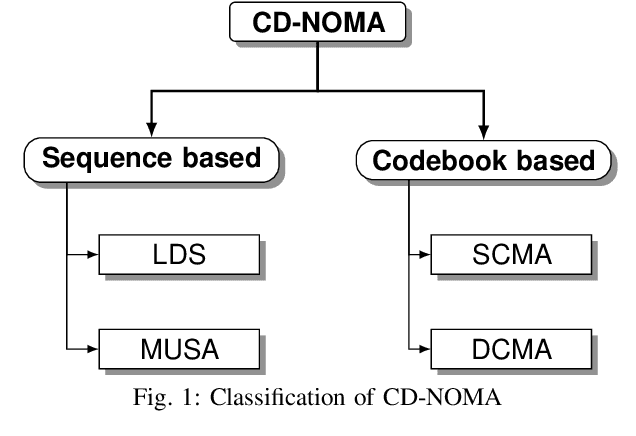
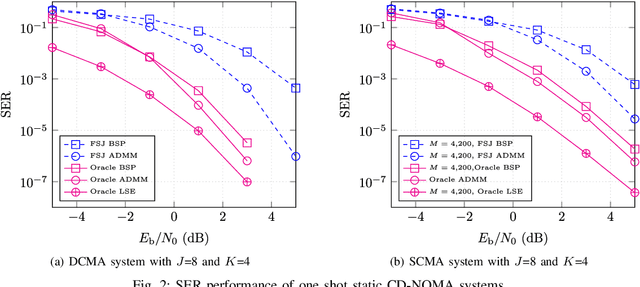

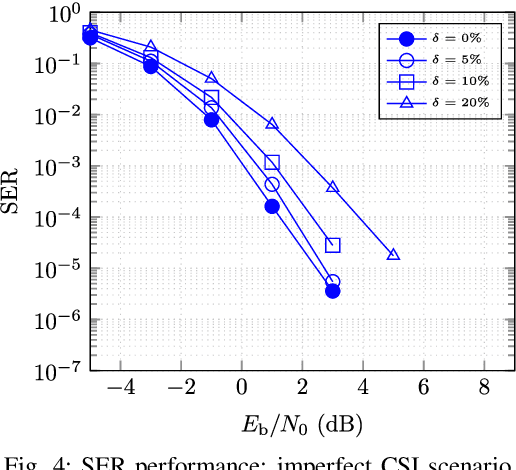
Abstract:Code-domain non-orthogonal multiple access (CD-NOMA) systems offer key benefits such as high spectral efficiency, low latency, high reliability, and massive connectivity. NOMA's ability to handle overloading allows multiple devices to share a single resource element (RE) for data transmission. In CD-NOMA, different users are assigned distinct codewords, which are leveraged during multi-user detection (MUD). Codebook-based NOMA systems outperform spread-sequence (SS)-based NOMA due to the coding gains provided by the codebooks. Sparse code multiple access (SCMA) and dense code multiple access (DCMA) are two prominent examples of such systems. Additionally, NOMA is seen as a crucial technology for enabling grant-free access, especially in massive machine-type communications (mMTC). One of the main challenges in deploying grant-free NOMA systems is accurately detecting both user activity and transmitted data, particularly when user activity fluctuates dynamically across the transmission frame. This paper introduces codebook-based grant-free NOMA systems modeled using a block sparsity signal structure. The joint activity and data detection (JADD) problem in these systems is formulated as group LASSO and sparse group LASSO block compressive sensing (BCS) problems. To address these, a robust prior information-aided alternating direction method of multipliers (ADMM) algorithm is proposed. Extensive numerical experiments and theoretical analysis show the efficiency of the proposed algorithm, making it a suitable solution for mMTC networks.
IRS-Assisted OTFS: Beamforming Design and Signal Detection
Aug 05, 2024Abstract:Intelligent reflecting surface (IRS) technology has become a crucial enabler for creating cost effective, innovative, and adaptable wireless communication environments. This study investigates an IRS-assisted orthogonal time frequency space (OTFS) modulation that facilitates communication between users and the base station (BS). The users attainable downlink rate can be boosted by collaboratively improving the reflection coefficient (RC) matrix at the IRS and beamforming matrix at the BS. Then, in the IRS-aided OTFS network, the problem of cooperative precoding at BS and IRS to improve the network throughput is framed. The precoding design problem is non-convex and highly complicated; an alternate optimization (AO) approach is proposed to solve this. Specifically, an approach based on strongest tap maximization (STM) and fractional programming is proposed. It solves RC matrix (at IRS) and beamforming matrix (at BS) alternatively. Moreover, an efficient signal detector for IRS-aided OTFS communication systems using the alternating direction method of multipliers (ADMM) is proposed. Finally, to estimate the cascaded MIMO channel, using a parallel factor tensor model that separates the IRS-User and BS-IRS MIMO channels, respectively is suggested. Simulation results show that the proposed method significantly enhances the system capacity and bit error rate (BER) performance compared to conventional OTFS.
Sparse Code Multiple Access (SCMA) Technique
Sep 17, 2023Abstract:Next-generation wireless networks require higher spectral efficiency and lower latency to meet the demands of various upcoming applications. Recently, non-orthogonal multiple access (NOMA) schemes are introduced in the literature for 5G and beyond. Various forms of NOMA are considered like power domain, code domain, pattern division multiple access, etc. to enhance the spectral efficiency of wireless networks. In this chapter, we introduce the code domain-based sparse code multiple access (SCMA) NOMA scheme to enhance the spectral efficiency of a wireless network. The design and detection of an SCMA system are analyzed in this chapter. Also, the method for codebooks design and its impact on system performance are highlighted. A hybrid multiple access scheme is also introduced using both code-domain and power-domain NOMA. Furthermore, simulation results are included to show the impact of various SCMA system parameters.ext-generation wireless networks require higher spectral efficiency and lower latency to meet the demands of various upcoming applications. Recently, non-orthogonal multiple access (NOMA) schemes are introduced in the literature for 5G and beyond. Various forms of NOMA are considered like power domain, code domain, pattern division multiple access, etc. to enhance the spectral efficiency of wireless networks. In this chapter, we introduce the code domainbased sparse code multiple access (SCMA) NOMA scheme to enhance the spectral efficiency of a wireless network. The design and detection of an SCMA system are analyzed in this chapter. Also, the method for codebooks design and its impact on system performance are highlighted. A hybrid multiple access scheme is also introduced using both code-domain and power-domain NOMA. Furthermore, simulation results are included to show the impact of various SCMA system parameters.
Convolutional Sparse Coding based Channel Estimation for OTFS-SCMA in Uplink
Jul 21, 2021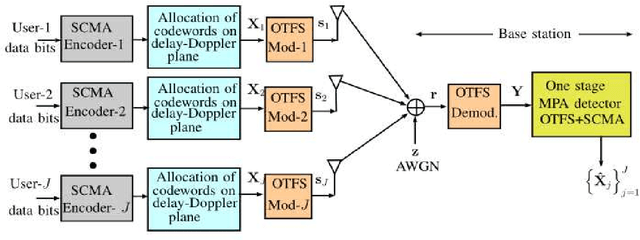
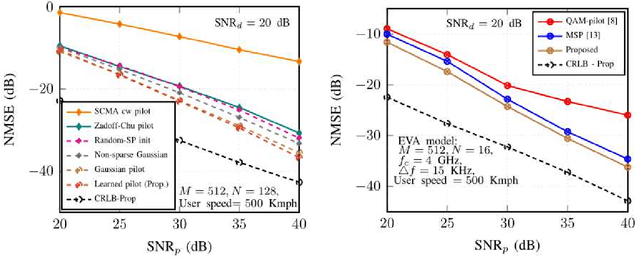
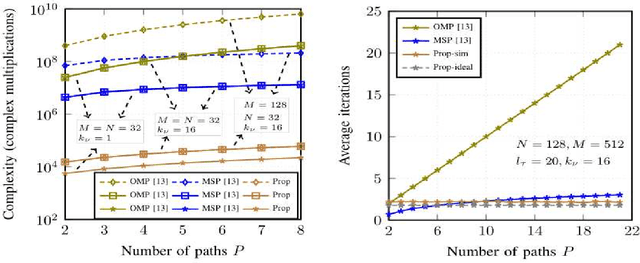
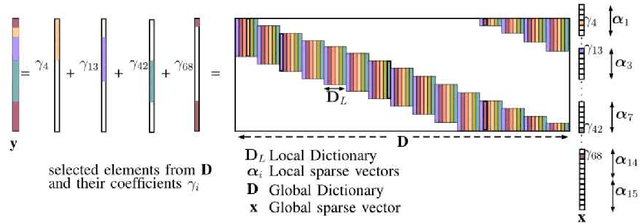
Abstract:Orthogonal time frequency space (OTFS) has emerged as the most sought-after modulation technique in a high mobility scenario. Sparse code multiple access (SCMA) is an attractive code-domain non-orthogonal multiple access (NOMA) technique. Recently a code-domain NOMA approach for OTFS, named OTFS-SCMA, is proposed. OTFS-SCMA is a promising framework that meets the demands of high mobility and massive connectivity. This paper presents a channel estimation technique based on the convolutional sparse coding (CSC) approach for OTFS-SCMA in the uplink. The channel estimation task is formulated as a CSC problem following a careful rearrangement of the OTFS input-output relation. We use an embedded pilot-aided sparse-pilot structure that enjoys the features of both OTFS and SCMA. The existing channel estimation techniques for OTFS in multi-user scenarios for uplink demand extremely high overhead for pilot and guard symbols, proportional to the number of users. The proposed method maintains a minimal overhead equivalent to a single user without compromising on the estimation error. The results show that the proposed channel estimation algorithm is very efficient in bit error rate (BER), normalized mean square error (NMSE), and spectral efficiency (SE).
 Add to Chrome
Add to Chrome Add to Firefox
Add to Firefox Add to Edge
Add to Edge